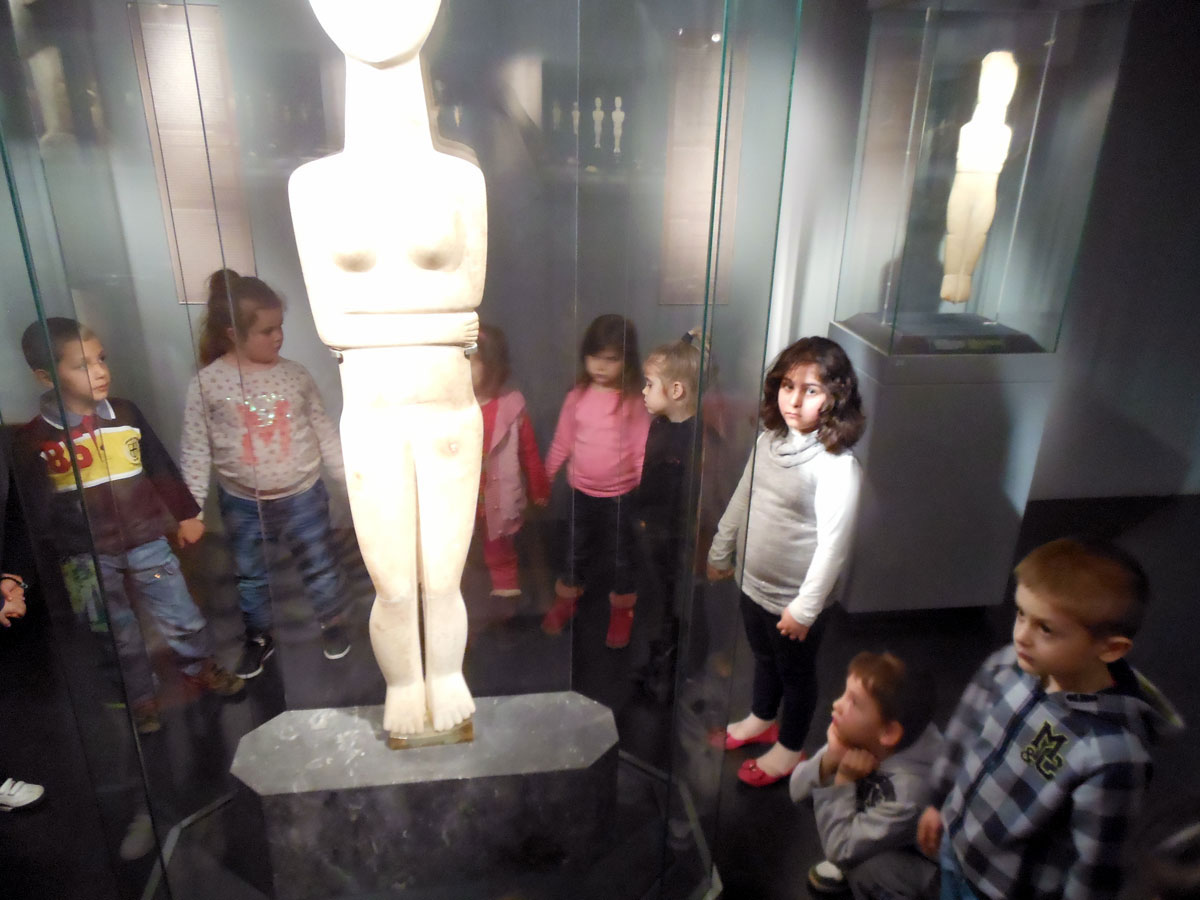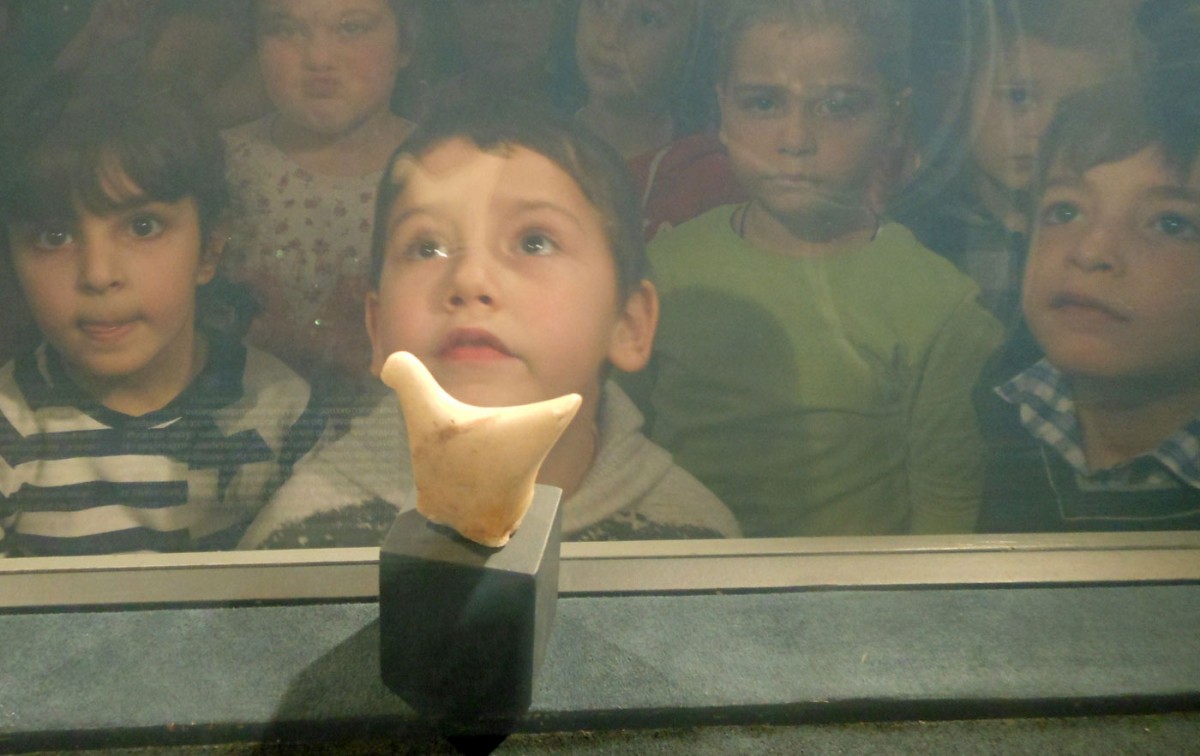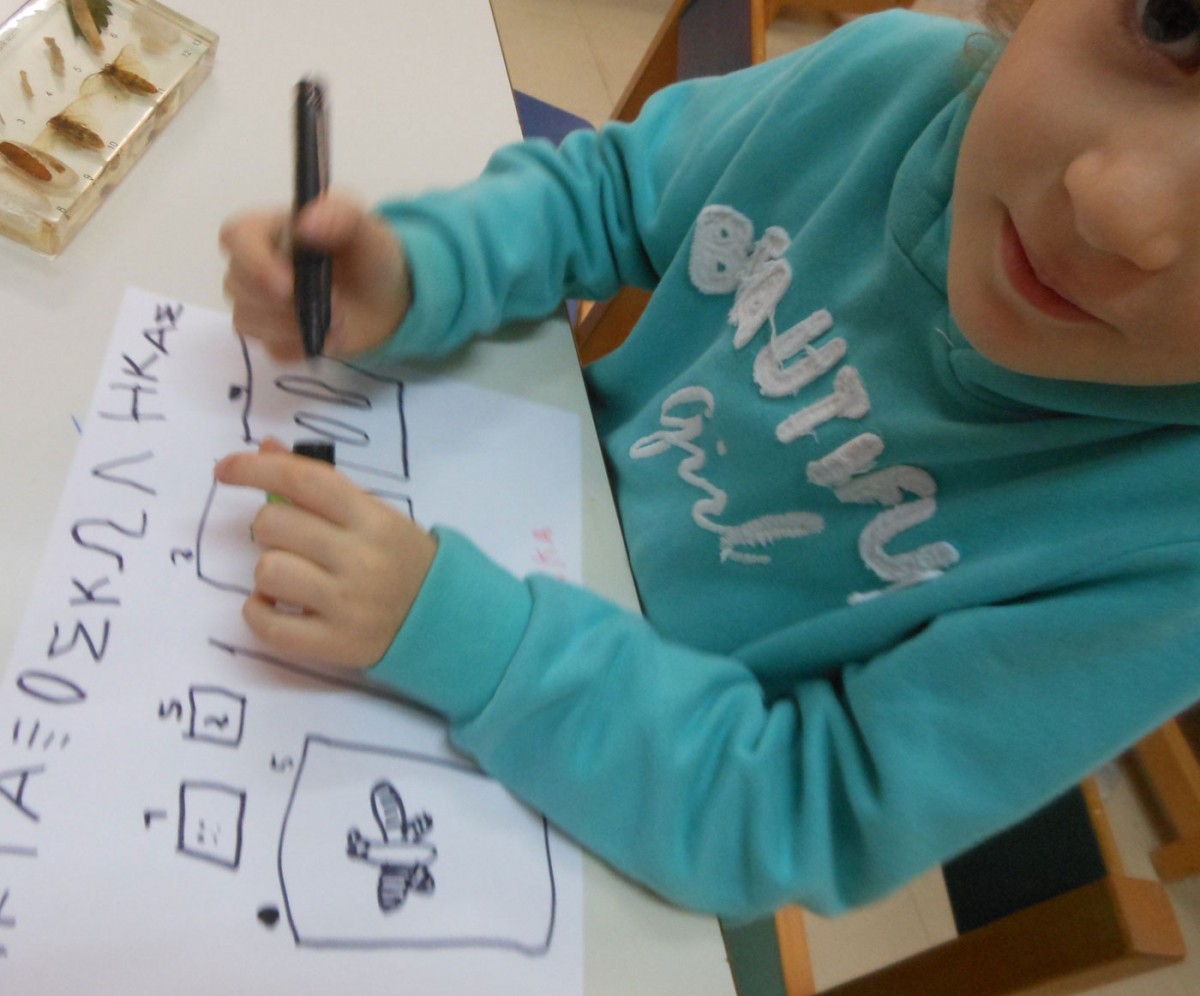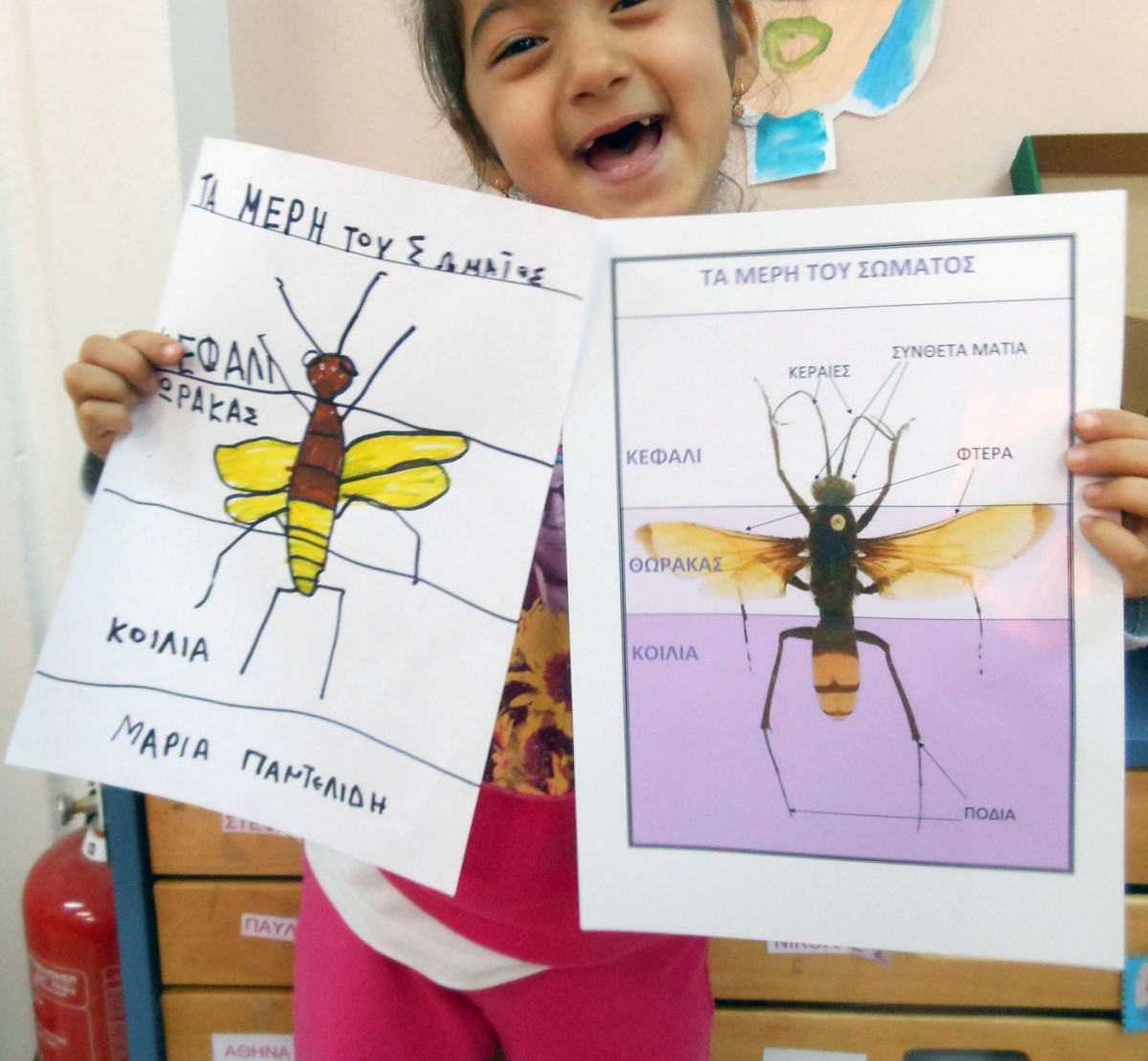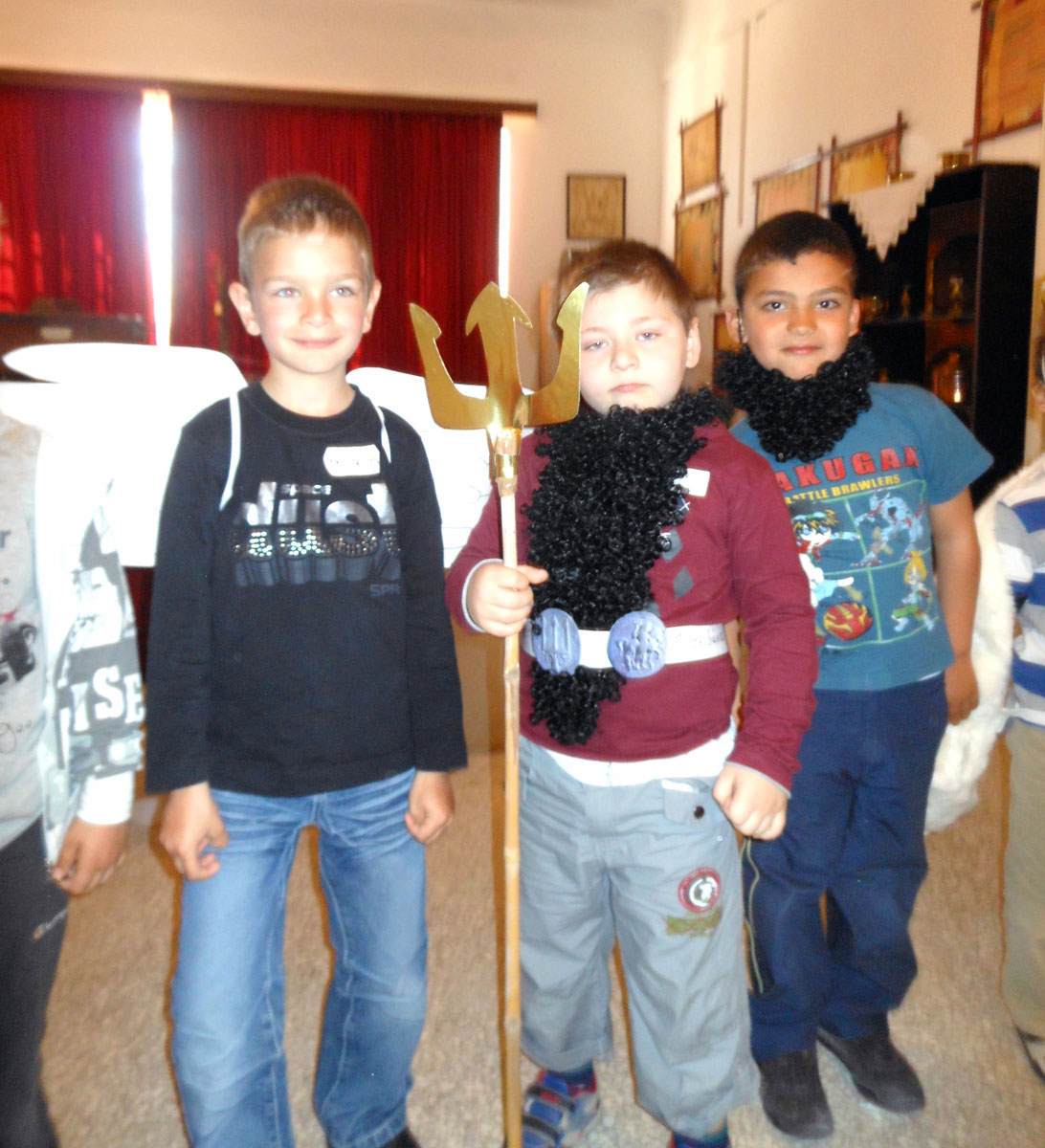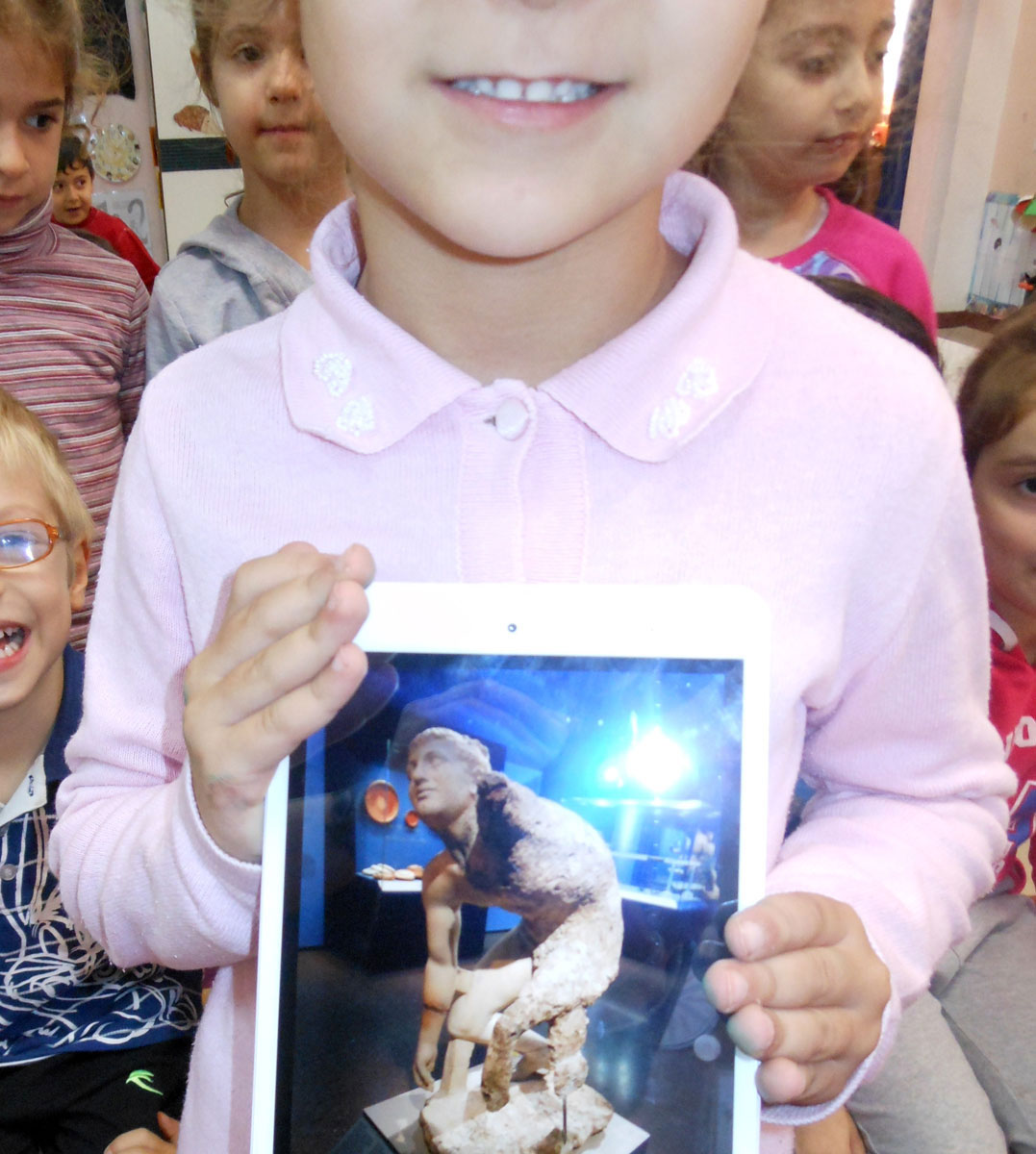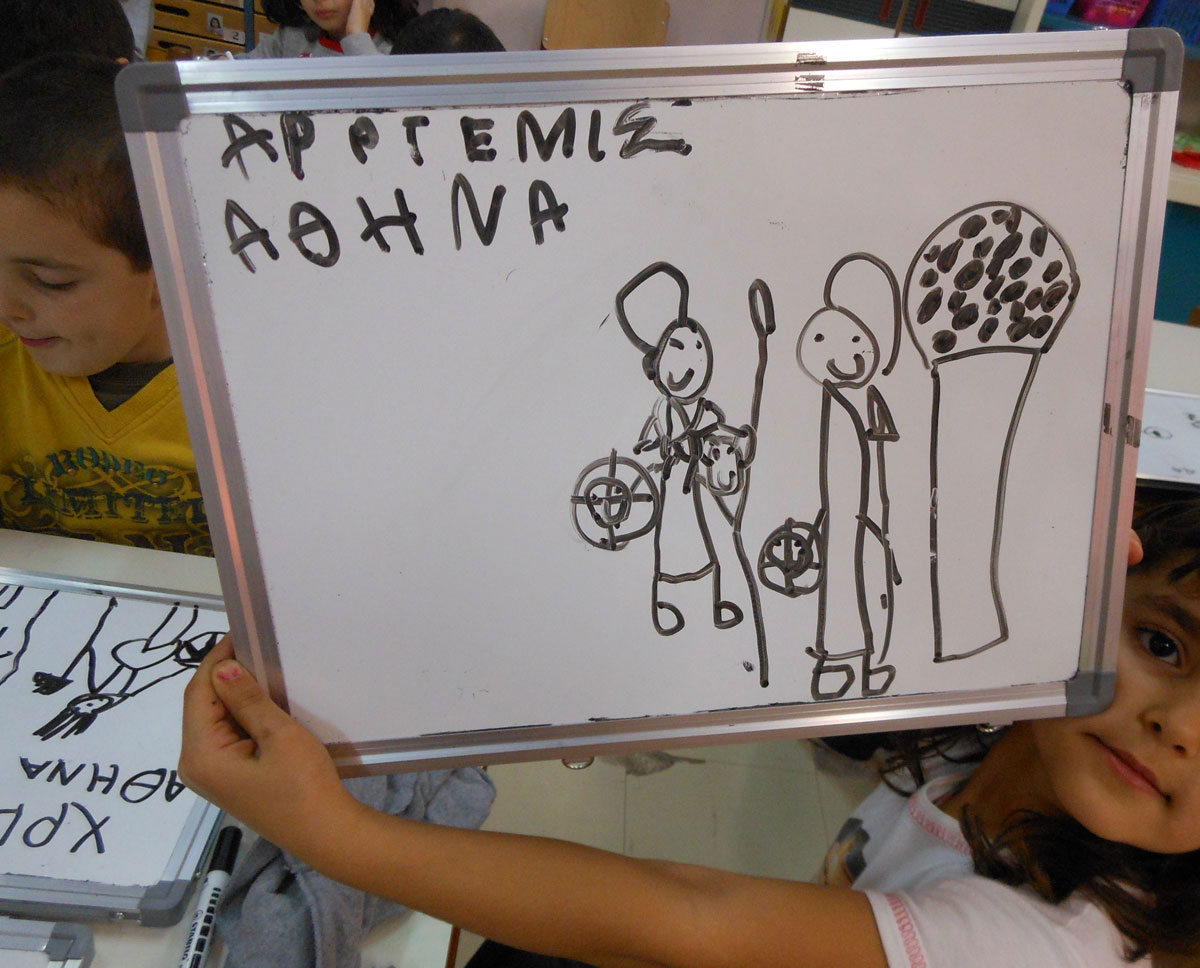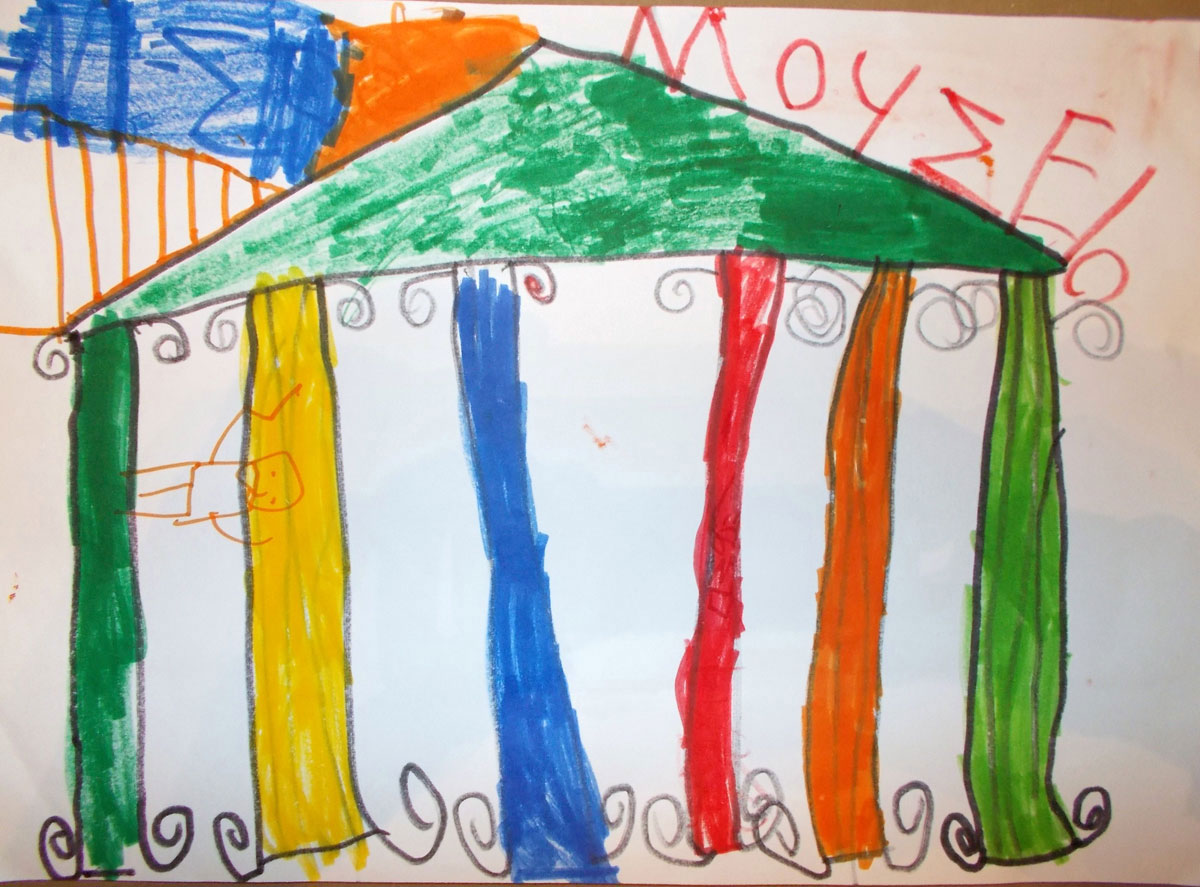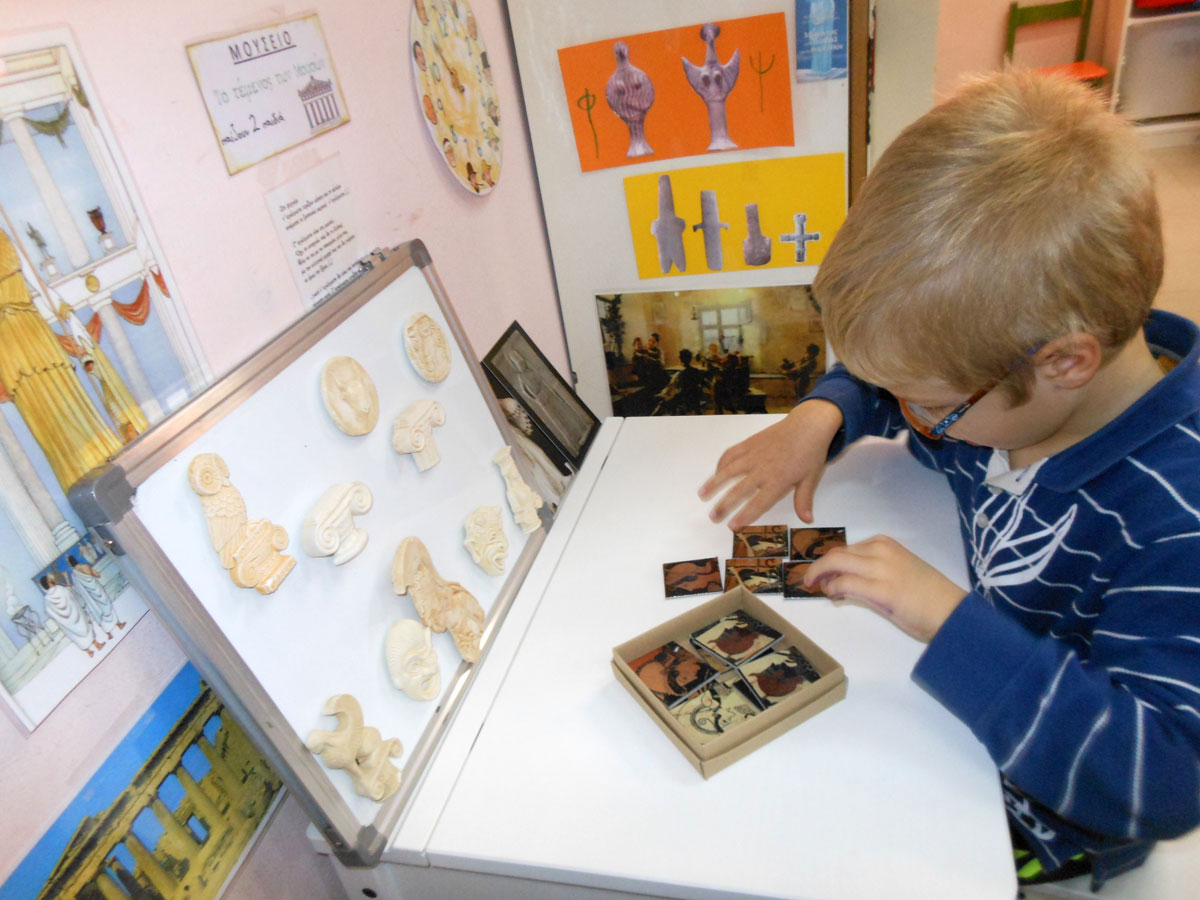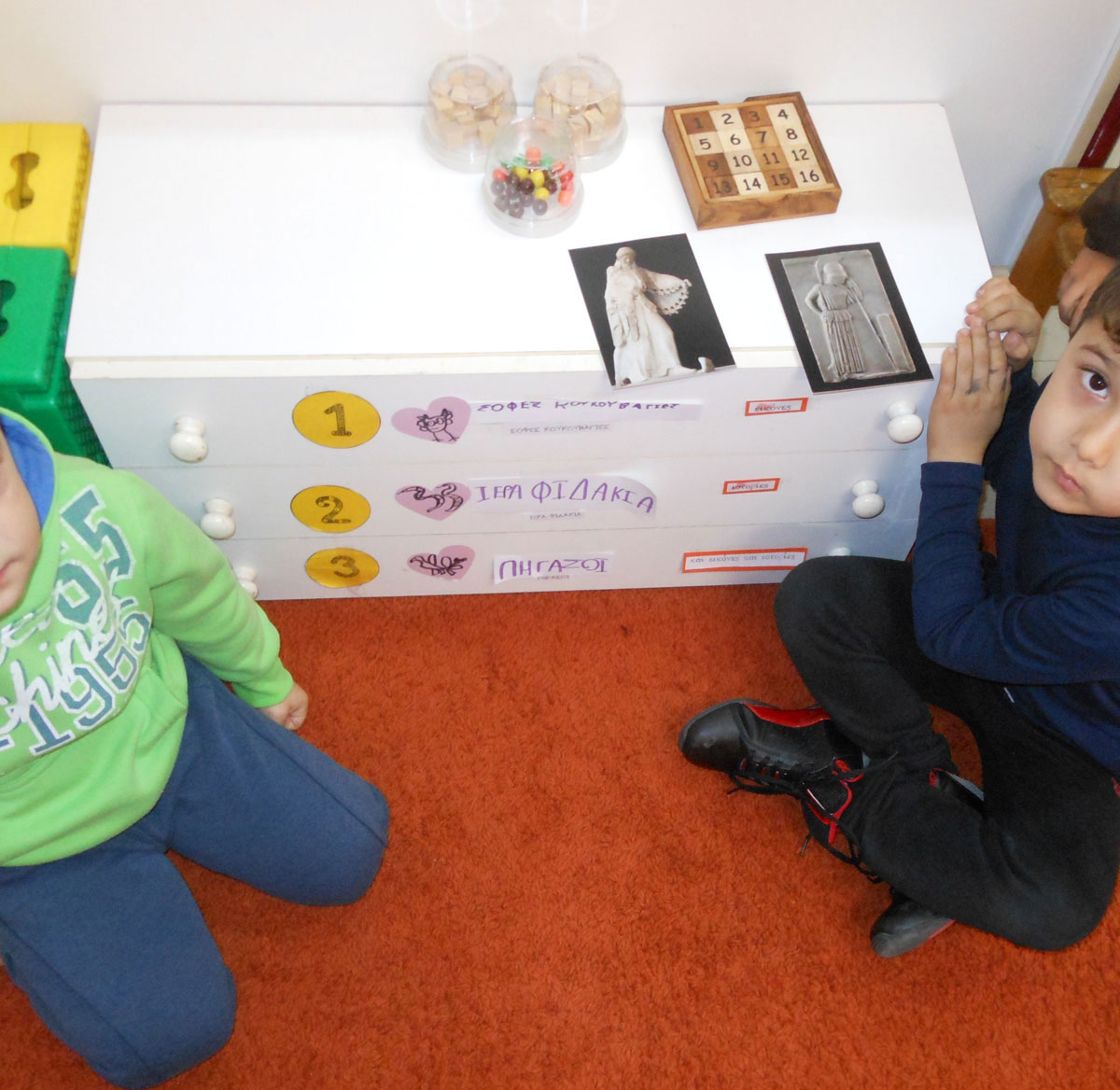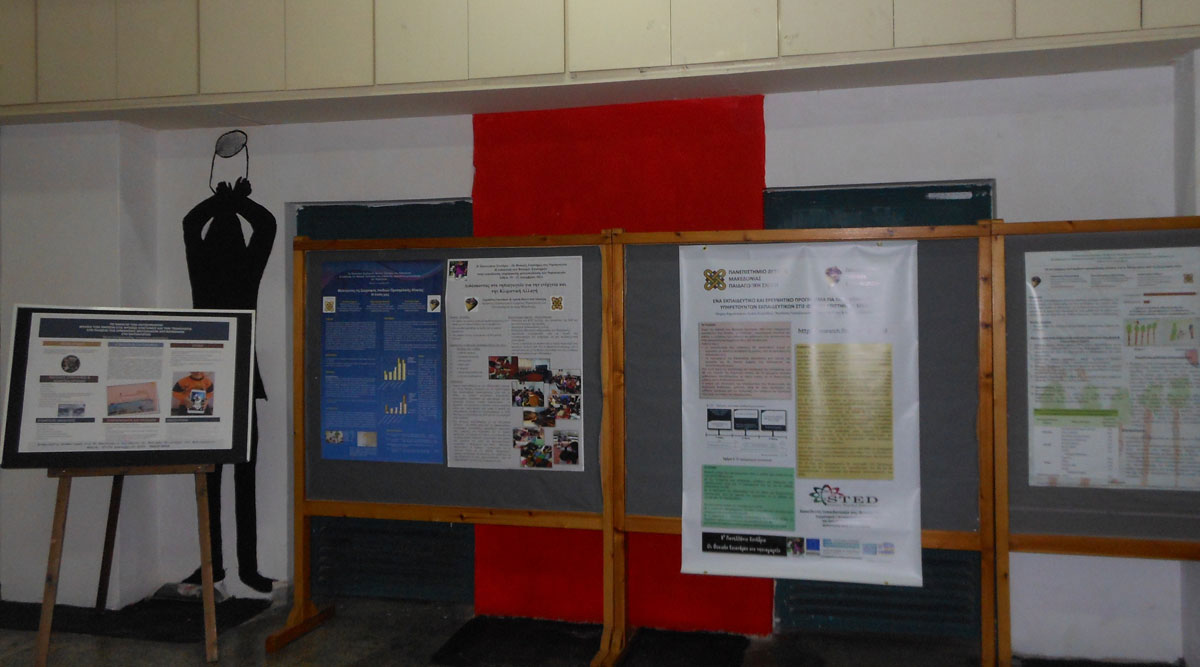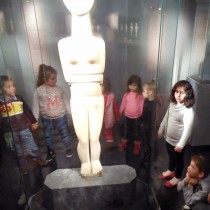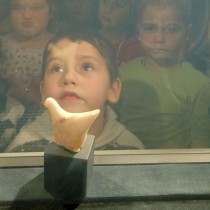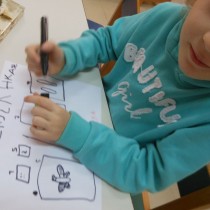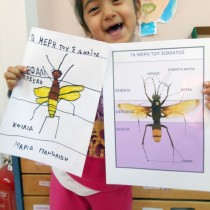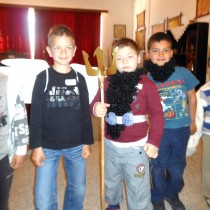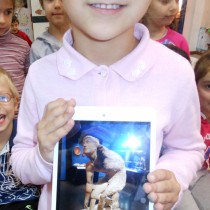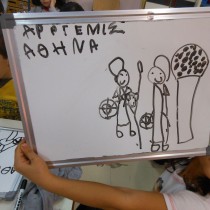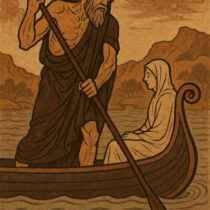This article aims to present good practices that try to strengthen relations between the museum and the nursery school. The discussion, regarding the educational role of museums and the museum educator, starts from the contemporary view point governing the nature of preschool education in our country. It focuses both on presenting indicative examples of educational museum practices already realized and on a more analytical portrayal of a recent museum activity in the form of a project.
The nursery school and its curriculum
The nursery school, as the first level of formal education in Greece, addresses the 4-6 age group (note 1). Its aim, according to legislation, is to help in infants’ all round development, i.e. physical, emotional, mental and social, within the context of the broader aims of primary and secondary education (note 2).
In the nursery school, a place where the course of learning is not standardized, activities do not limit themselves to preparing children for primary school, which is important as such, but by no means an end in itself. Whatever takes place in the nursery school contains the element of total engagement (note 3) by the children in every possible way, mainly through movement related activities, since with these, the formers’ interest is kept unflagging and over a long period of time (note 4). Learning, which is an undeniably social process (note 5), is supported with better results in a social environment where infants are seen as individuals that collaborate, interact and co act (note 6). Knowledge is approached as exploration and built through social activities such as games, problem solving, discussion and discovering together with others (note 7).
The new nursery school curriculum tries to create the framework for the organizing of learning and teaching, given that preschool education is the foundation for both an all round development in infants and their subsequent attitude towards learning. The infant’s personal empowerment and the shaping of a complete personality (note 8) are considered as key aims (note 9). The new programme is a reminder that knowledge is structured through children’s interaction with the natural and social environment with play being the dominant activity since, at both a personal and group level, playful conditions offer opportunities for interaction and experience. For this reason, the concept of social constructivism is mentioned (note 10). Each child’s natural curiosity is utilized through its explorations in an environment with the appropriate stimuli. Infants learn through a variety of teaching approaches and express themselves by different ways of representation. The definitive role of the teacher (whether he or she) is stressed (note 11), in organizing the teaching environment and planning the educational strategy by using as a tool the systematic observation and recording of the children’s needs, interests and development in terms of learning (note 12).
The nursery school curriculum and the methodology of each informed teacher of preschool children follow practices based on the social and cultural context of learning, taking into account contemporary scientific theories. For example, the activity theory (note 13) supports a dynamic building of knowledge, given that the participation of all those involved in the teaching process, also when mediating with the necessary tools, leads to this building of knowledge. Learning in nursery school is interdisciplinary, usually following two methods (note 14): either through topics chosen by the teacher and structured on the basis of the school group’s needs and preferences, or through projects. The latter result from the children’s exploratory interests stemming from their natural curiosity and are selected as specific topics by the infants themselves, while discussions determine the fields, the individual topics to be explored, the ways to act and where these ways lead.
In preschool education, experiencing is stressed, both in the sense of the child experiencing each of his / her activities and in the sense of personal living experiences, of previous experiences and the knowledge (note 15) a child has of its own culture. Experiential learning is realized both through playful situations that bring infants face to face with daily problems needed to be solved and through exploratory and recreational activities. Children’s involvement in situations they need to solve or successfully overcome so as to move on, is attempted not just for them to encounter knowledge in an interdisciplinary way. It is also done with the aim of their encountering the process itself –if possible, in its actual conditions– to have fun, to create, to activate their critical thinking, to live through beautiful moments, to feel they are richer in terms of personal satisfaction, rather than in terms of making use of time or acquiring material goods. Children’s needs are also emphasized. Apart from the daily need of a smooth, all round development according to their age, a key necessity for preschool children is their recognition both as individuals with unique personalities, as well as members of a group or many groups that are also unique and varied. Diversity in school groups is established through the different identities – not necessarily related to nationality, language or race. One of the priorities of the nursery school curriculum is the recognition of and respect for diversity. Thus the effort is encouraged to treat young children’s social and cultural experiences as an advantage rather than an obstacle and children with different learning profiles as capable of learning by alternative methods (note 16). In the nursery school the uniqueness of childhood is emphasized in each moment experienced by each child. The culture of every child is treated openly, with the right for a different identity being recognized as an element that is interesting and far reaching, this being a practice included in the intercultural approach to the educational process.
Preschool education’s counterbalancing effect attempts to make the most of whatever deficiencies, in favour of the pupils and their families, by offering essential stimuli for a child’s experiences, the broadening of his/her horizons, the creating of a basis for an optimistic view on life and a subsequent smooth course and good outcome. In this way, either failure in school can be prevented or the individual’s irregular progress, that may both perhaps lead to frustration in establishing a rounded and happy personality. Making the most of each child’s identity, achieved by creating proper conditions for communication (note 17) and collaboration, is an important element in securing the success of a child’s years in school.
The nursery school teacher’s job is to organize and operate the classroom and shape the learning environment, which she herself often improves to make it constantly attractive. She is also responsible for all the infants becoming integrated and well adapted, she determines the nursery school functions, the developing relationships, she influences learning, the class atmosphere, each pupil’s personality, the course followed and the results achieved by education.
The teacher’s role includes the ability to “read” the children’s explicit and implicit needs and to guide the pupils towards strengthening their abilities. It is important for the nursery school teacher to encourage the child to recognize its strong points, to plan specific individualized activities, according to the theory of multiple intelligence (note 18) and to support it in choices made by itself, by offering it a support framework (note 19) known as the scaffolding (note 20).
The museum and its educational role
As we know, awareness of the museum’s social role has led to museums turning towards the issue of communication (note 21) with their public and the development of relevant research (note 22) since the social dimension is included in the organization’s educational policy. George Hein believes that education (note 23) is the social service offered by museums as public institutions. Nevertheless, what quality of education are museums in need of? In the opinion of Nicholas Serota (note 24), a cultural institution today should not be like a museum-encyclopaedia or a museum-dictionary, since, as such, it refers more to a one way, linear movement of messages from transmitter to receiver, thus relying more on the behaviour theory (note 25) than on a wished for constructive (note 26) communication experience.
Schools and museums are both places of learning, training, communication and clearly of education; the former being used for the systematic, formal kind and the latter for the informal (note 27). According to the interactive model of communication (note 28), when planning and realizing its educational programmes and exhibitions, a museum takes into account its visitors’ previous experiences, knowledge and values (note 29), just as the school itself attempts to create a meaning on behalf of the pupils. Children’s museums have elements in common with the activities class room in a nursery school. One of these is that, just like nursery schools, children’s museums are transformed into an “educational playground”, providing, in a specially designed area, opportunities for discovery, experimentation, recreation (note 30), play and learning. The common starting point of both institutions is a multidisciplinary and interdisciplinary perception of learning and activities oriented towards active experiential learning through discovery. Aims and ways of approach often coincide. Museum education is the science that provides the methodology for an essential connection between museum and nursery school.
Individuals undertaking to carry out the various museum educational programmes, often by participating in their planning or being entirely responsible for them, are referred to in terms such as: animator, interpreter, mediator, museum educator. The term museum educator is connected to specific training in a particular field either of education or museology (note 31) and combines the corresponding skills. Since producing an educational programme “should be the work of a team and not just of one person” (note 32), the museum educator has many roles to play and needs to possess professionalism, expertise, increased qualifications and teaching effectiveness.
Educational practices of museums and museum practices of nursery schools
Today, the collaboration between a museum and a nursery school is considered a prerequisite for both institutions to operate effectively (note 33).
The following museum educational activities are some out of many realized in an attempt at an “opening” towards schools or a connection with them: the carrying out of educational programmes in museums, the creation of museum kits that travel from school to school, the production of a variety of educational material, workshops or seminars for the training of animators-interpreters who aim to further educate teachers, museum educators, volunteers and other interested parties.
On the part of museums, educational programmes are a process based on active methods of learning, designed to take into account the needs and abilities of a particular public, the specifics of the space involved and, perhaps, the detailed programme of the school (note 34). When surveying museum websites, educational programmes, compared to other practices such as workshops, educational material and museum kits, seem to be the dominant museum activity, when schools are the target groups, perhaps because the first are considered as a direct form of communication while the rest are seen as indirect (note 35).
A restraining factor in the effectiveness of museum practices is the teachers’ attitude and degree of involvement. Sometimes they, the teachers, remain distanced from activities that take place in the museum and are addressed to pupils. This is by no means the rule and possibly may vary according to the pupils’ age and depending on the degree of each school group’s autonomy. For example, infants may find it difficult to part from their nursery school teacher in the museum, perhaps because they feel secure near her, or because she herself believes that by actively participating, she encourages the children’s response to the educational programme. In some cases, teachers join in to modify or redesign part of the educational programmes. In others, the teachers themselves organize their own programme, utilizing material provided by the museum, but it is, however, necessary for them to have become familiar with methods of utilization, such as the way of choosing objects, spaces and ideas. An ideal case would be for teachers to be able to include museum education in the everyday life of the classroom “in an organized and systematic way, both with visits to museums or sites and with in class applications with museum material either original or reproduced”, according to their own teaching schedule (note 36).
At a preschool level, the most common practice towards encountering a museum is for school groups to visit it, where the infants can be taken on a simple guided tour or take part in some educational programme either provided by the institution itself or designed by the teacher. The museum visit can result as a choice taken freely by the pupils (note 37) and teachers so as to enjoy themselves and enrich their daily lives with something different. It can also arise from the need to link in school activities with museum objects or museum operations, such as infants visiting a museum to learn how the conservation department functions or to meet museum professionals. This effort is encouraged by the Departments of Cultural Affairs of the Directorates of Education represented by the Coordinators for Cultural Activities. This institution by the Ministry of Education, also addressed to preschool education, reinforces the dialogue between the school and the museum (note 38).
Indicative examples of practices
As part of a school unit, nursery school teachers have the flexibility to choose the topics dealt with in class, as well as the expertise and methodology. With these as a given, they can easily incorporate museum education in their schedule. Nursery school teachers have the opportunity to make the most of a museum exhibit towards strengthening the infants’ contact with the museum, either by interspersing references on specific museum objects when teaching with pictures, or when realizing projects or educational programmes involving museums. An important step in reinforcing both the infants’ appreciation of the museum and consequently that of their parents, siblings etc., is for children to prepare for a visit to the museum, even when this is not connected to a specific section, as well as their utilizing museum material during or after the visit.
Presented below are some small scale activities that have been realized so as to shape and cultivate positive attitudes and relations between the nursery school and the museum. These have been carried out since 2010 with positive results (note 39) in a state nursery school in the Acharnon district.
- Design and realization of educational programmes or simple visits by nursery schools to museums, prepared ahead of time and in collaboration with the people involved, such as kindergarten teachers, museum educators, animators and others, so as to exchange facts and build an interactive relationship that will optimize the result (fig. 1).
- Participation in programmes realized in museums under the auspices of institutions such as e.g. some university or, following approval, the Departments of Cultural Affairs of the Directorates of Primary Education (figs. 2, 8). The support of such institutions encourages the participants’ degree of involvement.
- Daily in class assessment of stimuli from museum objects, works of art, cultural data or the simulation of museum functions (for example, the infants design and curate a small exhibition of objects in a corner of the museum, make the objects’ reproductions on the computer, prepare texts etc., see figs. 3 and 4, having been given a museum kit).
- Visits to local museums or collections with an emphasis on the experiential and recreational element, where the infants have the right to enjoy their trip and play a little, without being obliged to produce work. They can e.g. play a theatre game (fig. 5) instead of completing work sheets, in the context of an educational programme designed for the specific occasion.
- Design and realization of activities of an exploratory nature, such as projects, on the occasion of museum exhibitions. The projects are often completed by disseminating the good practices which provide feedback and extra motivation for fresh activities (figs. 6, 11).
- Design and realization of activities of an exploratory nature, such as projects, that end up with a museum trip, for children to come into contact with the authentic objects and provide them with nourishment for their creations and narratives (fig. 7).
Example of a museum activity in the form of a project
During the previous school year, a project called “The Goddess Athena is everywhere” was realized in a state nursery school in the Acharnon district. The occasion was the children elaborating on the topic of the olive and olive oil. When it was found that there was a gap in the pupils’ knowledge on the myth of Athena’s quarrel with Poseidon, a series of interdisciplinary activities followed, designed for the specific occasion, that got the infants thinking and raised a considerable number of questions.
During the brainstorming session (note 40), the nursery school teacher recorded and charted the children’s ideas and questions. This chart was later copied by the children on a cardboard and illustrated with small sketches. Since the infants’ research was the starting point, the project, with help from the teacher, was guided by their own wishes and decisions (note 41) and evolved according to the typical steps of a project (note 42).
The pupils initially found that their ideas were interesting, but at the same time they expressed their concern that perhaps there was too much material to collect either for them to succeed or be easy for their parents who were helping them. Some of them suggested that the kindergarten teacher should be responsible for the whole project, but following a discussion, they decided to take it on by dividing the work into groups. So, they put together three action groups they gave different names to. The first, called “Wise owls” gathered visual material on Athena and her symbols from different sources, such as pictures of sculptures, coins, banners, sketches etc. The second group, called “Sacred small snakes”, tried to collect stories and myths about the goddess, while the third group, the “Pegasoi”, brought books, films, pictures and stories about other gods in mythology. It had been decided by the children themselves that each group should separately arrange, (with no leaking of information, to retain the element of a mounting excitement, curiosity and discovery) the material in three drawers, numbered and with a title, so as to first read it on the outside and then open the drawer to put in the material. Each drawer contained the material of the respective group (fig. 10). The processing of the group’s material and the evolving of the activities happened on different days so as to avoid fatigue and confusion brought on by a barrage of information. The infants gradually found answers to their questions, as the project activities evolved. The children constantly came up with ideas both for various games of discovery and subject matter for drawing or writing (note 43). New questions arose in due course, requiring new answers. As the children became aware that the depictions of the goddess were actually authentic objects, they asked to visit the archaeological sites or museums where the latter are displayed. At this stage, however, a place was claimed by a new, small survey of interesting points that, having been collected and recorded in a list, gave the project its final title of “The Goddess Athena is everywhere!”. It was decided to visit the Acropolis Museum escorted by the parents (note 44). This was the infants’ decision, when they realized that most of the exhibits that interested them were gathered in that particular museum.
At the stage before the visit to the museum, the infants, along with the teacher, drew up a plan of action for the day of the visit. On a roll of paper, they put down their ideas about what they wanted to do in the museum. They prepared the printed matter with their teacher, a move which proved especially helpful as it ultimately contributed to the children becoming familiar with this material. The children’s wishes met with restrictions, when discussed before the whole class. Since they intended to draw inside the museum, they had to discuss about appropriate materials for this activity, as well as spots in the museum where they could sit without disturbing anyone. They were not, however, familiar with the space. One child suggested they phone for information or look at the museum halls in a photograph. This idea, through association, led to finding information about the game-application (note 45), a very amusing activity for young children, on the museum’s website. After this virtual tour, the infants came to the conclusion that it was difficult to sit somewhere and draw. In the same way, they rejected other ideas as well such as playing hide and seek, a game that might cause an upheaval, or sitting on the floor to be told a story. Instead of the above, they thought it better to play “Τhe game of the hidden goddess Athena” (note 46). This process of approving or rejecting ideas, led to constructing a number of possibilities and restrictions inside the museum, a topic to which the children returned with a critical attitude during the phase of the trip’s final assessment. The children’s views were discussed with the parent escorts who were informed by the nursery school teacher about the activities’ scenario, the time available and making the most of the printed material.
During the visit to the museum, it was decided that the activities should be carried out discreetly, so as not to disturb the guided tour of other visitors to the museum, which is often very busy. One fact that disappointed the children was that the museum staff did not allow the photographing of the activities. To facilitate things, the group of infants was divided, according to plan, into smaller groups. The teacher encouraged both children and parents to participate in the game of discovery (note 47) and to locate the objects which they would focus on. Each group, coordinated by a parent, received postcards showing exhibits depicting Athena and a table with all these pictures where they would put a tick next to the exhibit they were able to locate. In front of each exhibit, the parent using the so called midwife’s method (note 48), asked questions which the infants attempted to answer and interpret. They used the information material of the accompanying texts making notes of key words on the back of the postcards and some of their own remarks with the help of the adults. When the groups reassembled, they presented the result of their exploratory tour, exchanged opinions (note 49), showed the postcards of exhibits they had managed to locate in the exhibition space, made particularly apt remarks and talked about their impressions. The nursery school teacher kept rough notes of what was said and asked if the objects created certain associations for them. The infants replied enthusiastically and some dramatically declaimed phrases supposedly spoken by the goddess Athena, or briefly narrated stories about her as they remembered them from the discussions in class, during the preparatory stage.
After the visit, opening the drawers with the material they had previously collected, the infants tried to remember and locate the pictures of the exhibits that they had seen as authentic objects in the museum. They then created a cross-tabulation table (note 50) sticking the pictures on a piece of cardboard and putting crosses in the boxes to “record” their preferences about which a discussion with arguments followed. In the end, they chose the exhibit they would utilize for the poster they later made. It was unanimously decided that the postcards used in the museum during the visit should be placed in the museum corner (note 51) of the class room, with captions invented and written by the children. Over the next few days, even during activities on other topics or during routines (note 52), the discussion revolved round the impressions of the pupils who asked to repeat games they had already played, while also suggesting new ones. One of these was the playing of roles and dramatization of the myth of Athena’s quarrel with Poseidon, in which the interpretations of the parts were now much more persuasive and spontaneous. The new ideas were a pantomime based on the post cards of the exhibits, a collection of additional material from other museums, the creation of three dimensional works of plasticine (note 53) depicting Athena, the sacred snakes and the wise owls, a construction of paper dolls for a puppet show in a corner of the classroom, dressing up with fabrics and various materials from the dressing up corner.
The infants assessed the programme through visual representation, discussion and activities. The parents participated in the assessment with the use of a questionnaire and an aural discussion in the form of an interview.
The children’s discussions on the goddess Athena and their willingness to do similar brief research, kept them interested (note 54) and animated till the end of the school year because truly… “the goddess Athena is everywhere”.
The examples referred to above are everyday practices that took place in a nursery school with pupils from repatriated families. The particularity of these infants’ culture was taken into account in all the careful efforts made in approaching the museum commodity, so as to use both school and museum stimuli in a way to make up for the deficiencies in this particular community of pupils (note 55). From the start of their implementation, these perhaps seemingly insignificant activities had a positive influence on cultivating a higher motivation for learning both on the infants’ behalf but also on that of their parents.
To realize such practices, good planning is required that takes into account data of the preschool schedule and the theories of museum education. A vision of this systematic effort in applying good practices is the encounter and fruitful interaction between the museum and the nursery school, which are processes that create a solid foundation for people’s appreciation in museums, learning, culture, thereby leading to their investing in the commodity of culture.
Venia Deligiannidis
Nursery school teacher (ΠΕ60) with a postgraduate degree in Museum Studies
*Thanks are due to Dr Marlen Mouliou for her suggestions and overall support.
